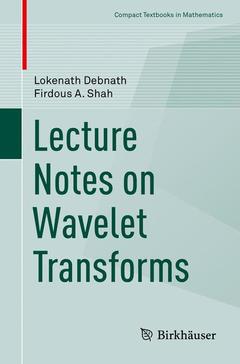Description
Lecture Notes on Wavelet Transforms, 1st ed. 2017
Compact Textbooks in Mathematics Series
Authors: Debnath Lokenath, Shah Firdous A.
Language: English
Subject for Lecture Notes on Wavelet Transforms:
26.36 €
In Print (Delivery period: 15 days).
Add to cart
Publication date: 09-2017
Support: Print on demand
Support: Print on demand
Description
/li>Contents
/li>Biography
/li>Comment
/li>
This book provides a systematic exposition of the basic ideas and results of wavelet analysis suitable for mathematicians, scientists, and engineers alike. The primary goal of this text is to show how different types of wavelets can be constructed, illustrate why they are such powerful tools in mathematical analysis, and demonstrate their use in applications. It also develops the required analytical knowledge and skills on the part of the reader, rather than focus on the importance of more abstract formulation with full mathematical rigor.
These notes differs from many textbooks with similar titles in that a major emphasis is placed on the thorough development of the underlying theory before introducing applications and modern topics such as fractional Fourier transforms, windowed canonical transforms, fractional wavelet transforms, fast wavelet transforms, spline wavelets, Daubechies wavelets, harmonic wavelets and non-uniform wavelets.
The selection, ar
These notes differs from many textbooks with similar titles in that a major emphasis is placed on the thorough development of the underlying theory before introducing applications and modern topics such as fractional Fourier transforms, windowed canonical transforms, fractional wavelet transforms, fast wavelet transforms, spline wavelets, Daubechies wavelets, harmonic wavelets and non-uniform wavelets.
The selection, ar
The Fourier Transform.- The Time-Frequency Analysis.- The Wavelet Transforms.- Construction of Wavelets via MRA.- Elongations of MRA Based Wavelets.
Lokenath Debnath is a Professor of Mathematics at the University of Texas–Pan American.
Firdous A. Shah is a Professor of Mathematics at the University of Kashmir in India.
Written from the ground up to provide a comprehensive introduction to wavelet analysis
Provides an accessible working knowledge of the analytical and computational methods of wavelet analysis
Concise, yet highly accessible to both pure and applied mathematicians, as well as scientists and engineers
Includes supplementary material: sn.pub/extras
© 2024 LAVOISIER S.A.S.




